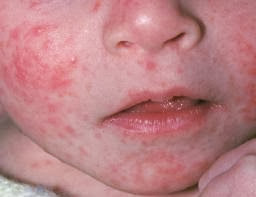Seborrhoeic dermatitis in infants is a type of skin inflammation which primarily affects the scalp and face. The precise explanation for seborrhoeic dermatitis is not known. It is thought that infants who develop this condition may produce extra oil (sebum) from the sebaceous glands in their skin. The fungal germ lives within the sebum of human pores and skin and a few babies might react to the germ indirectly which causes the pores and skin inflammation.
It does not usually occur in older children. Some youngsters and adults have a related situation which causes bad dandruff and a rash. Seborrhoeic dermatitis in babies causes dangerous dandruff (cradle cap). Seborrhoeic dermatitis is extremely common in infants. Seborrhoeic dermatitis presenting in infancy is a quite common situation which can be dropped at the eye of the health visitor or GP.
In the majority of circumstances it is a benign self-limiting condition which normally clears spontaneously through the first 6-12 months of life but, in a small quantity, it can be notably troublesome and require treatment.
Seborrhoeic dermatitis happens mostly in the lipid-wealthy areas of pores and skin and, in infants, happens predominantly on the scalp and upper face, producing an look which may give rise to some concern from parents.
Recommended treatment for seborrhoeic dermatitis in babies
Treatment will not be usually needed, as the situation is usually mild, isn't critical, and does not usually trigger any discomfort to the baby. If different areas are affected, common washing helps. Use an emollient cream instead of cleaning soap on the affected skin.Easy measures should be advised first, such as regular washing of the scalp with child shampoo, followed by brushing with a smooth brush to loosen scale. Prior to shampooing, the scales may be softened with child oil. If essential, crusts may be soaked in a single day before washing, with white petroleum jelly or warmed vegetable/olive oil. There is some controversy within the literature about the use of olive oil.
DermNet NZ maintains that olive oil encourages growth yeasts of Malassezia spp. and needs to be avoided. Nonetheless, a NICE proof search in 2013 didn't discover adequate evidence that olive oil should be avoided, and the NICE Scientific Information Abstract of 2013 continues to recommend its use as one of quite a few choices as above. Ketoconazole 2% cream (or another imidazole cream) may be used a few times a day, if required.
If needed, a medicated shampoo or an antifungal cream equivalent to ketoconazole cream could also be prescribed by your doctor. Hardly ever, if inflammation is extra extreme, a gentle steroid cream could also be prescribed by your doctor.









0 comments:
Post a Comment